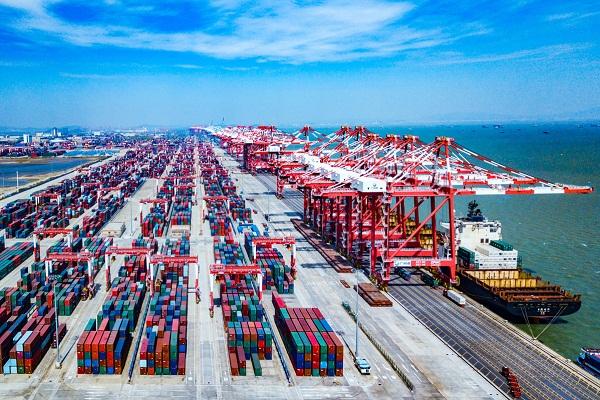Nansha port turns smarter, more efficient

Photo shows a view of Nansha Port in Guangzhou, South China's Guangdong province. [Photo provided to chinadaily.com.cn]
High-tech efforts bear fruit as district now a key transportation hub in GBA
Inside the active testing area of the fourth phase of Nansha port in Guangzhou, Guangdong province, containers are handled automatically by intelligent guided vehicles and yard cranes, after regular testing of the operation started in April.
Construction of the new terminal began in late 2018, which is designed with two 100,000-metric-ton berths, two 50,000-ton berths, 12 barge berths and four working vessel berths.
"The terminal, equipped with advanced intelligent facilities in its on-and-off loading and control center, would help greatly promote the coordinated development of ports in the Guangdong-Hong Kong-Macao Greater Bay Area," said Li Rong, an engineering technology manager of the fourth phase of Nansha port.
Accelerating construction of the port's fourth phase, along with supporting the GBA to build a joint shipping and logistics trade center, has become part of an overall plan to promote comprehensive cooperation in Guangdong and the two special administrative regions.
The State Council, China's Cabinet, recently issued an overall plan to facilitate comprehensive cooperation within the GBA by further deepening opening-up in Nansha district.
The plan will be implemented in the whole area of Nansha, covering a total area of about 803 square kilometers, with Nanshawan, Qingsheng hub and Nansha hub in the district, which is already part of the China (Guangdong) Pilot Free Trade Zone, serving as launching areas in the first phase, according to a circular issued by the State Council on Tuesday.
After the completion of Nansha port's fourth phase, the annual container throughput of the port is expected to exceed 24 million twenty-foot equivalent units, ranking tops for a single port area in the world.
To help enhance cooperation in shipping and logistics, the local Customs has introduced smart innovative technologies in the whole process of Customs clearance, said Deng Tao, deputy commissioner of Nansha Customs.
"Intelligent supervision means smart mapping review and inspection assistant robots using 5G technology have been deployed, offering 'one-stop' and efficient Customs clearance for import and export enterprises," Deng said.
Integrated logistics operations between the Nansha port and several inland river terminals along the Pearl River have also been implemented, Deng said.
"The integrated logistics operations, so far covering 13 river terminals in Guangdong, have played an important role in improving the overall service level of the port cluster in the GBA," Deng said, adding that since early this year, the integrated sea-river port service has helped transport more than 34,600 TEUs.
In addition to building Nansha into an international shipping and logistics hub, the construction of a scientific and technological innovation industry cooperation base and youth entrepreneurship and employment cooperation platform for the GBA will be accelerated, according to the plan.
By 2025, the scientific and technological innovation systems and mechanisms in Nansha will be further improved, industrial cooperation will be deepened and regional innovation and industrial transformation systems will be preliminarily established, according to the plan.
According to the local district government, an innovation and entrepreneurship industrial zone will be built around the Hong Kong University of Science and Technology (Guangzhou), which will open its doors in September in Nansha.
"The innovation and entrepreneurship industrial zone will help transfer international scientific and technological achievements," said Xie Wei, deputy Party secretary of the Nansha Development Zone Party Working Committee.
Nansha, located in the geometric center of the GBA, will undoubtedly hold vast potential for development in gathering innovative elements with Hong Kong and Macao, said Lin Jiang, deputy director of the research center of Hong Kong, Macao and the Pearl River Delta Region, Sun Yat-sen University.
"Scientific and technological innovation is not a castle in the air. It needs to be implemented in specific industries. Without industries as the basis, enterprises and high-end talent would not gather," Lin said.
According to the local science and technology authorities, Nansha is currently building key industrial clusters including intelligent connected vehicles, third-generation semiconductors, artificial intelligence and aerospace.
In the AI sector, Nansha has gathered more than 230 enterprises with independent core technologies and has initially formed an AI research and development cluster covering the fields of AI chips, basic software algorithms and biometrics.
All rights reserved. Presented by China Daily









